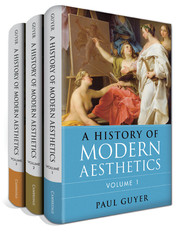Book contents
- Volume 1 The Eighteenth Century
- Volume 2 The Nineteenth Century
- Volume 3 The Twentieth Century
- Frontmatter
- Contents
- Acknowledgments
- Introduction
- Part One German Aesthetics in the Twentieth Century
- Part Two Aesthetics in Britain until World War II
- Part Three American Aesthetics in the First Half of the Twentieth Century
- Part Four Wittgenstein and After
- Bibliography
- References
Introduction
from Volume 3 - The Twentieth Century
Published online by Cambridge University Press: 05 June 2015
- Volume 1 The Eighteenth Century
- Volume 2 The Nineteenth Century
- Volume 3 The Twentieth Century
- Frontmatter
- Contents
- Acknowledgments
- Introduction
- Part One German Aesthetics in the Twentieth Century
- Part Two Aesthetics in Britain until World War II
- Part Three American Aesthetics in the First Half of the Twentieth Century
- Part Four Wittgenstein and After
- Bibliography
- References
Summary
In Volume 1, we saw how two alternatives were developed during the course of the eighteenth century to the traditional approach to aesthetic experience as a form of cognition or insight into truth, what has been called here the aesthetics of truth, namely, the idea that aesthetic experience is a free play of our cognitive or more broadly mental powers, the aesthetics of play, and the recognition of the emotional impact of aesthetic experience, especially the experience of art, the aesthetics of emotional impact. A few thinkers, including Moses Mendelssohn and Johann Georg Sulzer in Germany and Lord Kames in Britain, at least suggested a comprehensive attitude to aesthetic experience synthesizing all three of these, but Immanuel Kant rejected the importance of emotional response in aesthetic experience and in his theory of fine art combined only the traditional aesthetics of truth with the novel aesthetics of play. Among Kant’s immediate contemporaries and successors, a few made gestures toward adding emotional impact into Kant’s mix.
But as we saw in Volume 2, the predominant response among Kant’s most prominent successors in the early nineteenth century was not to add emotional impact back into a comprehensive aesthetic theory; rather, they accepted Kant’s exclusion of emotional impact but also rejected his theory of play, thus reverting to an essentially cognitivist approach to aesthetics, although with a decidedly metaphysical twist. This was certainly true in the cases of Friedrich Schelling, Arthur Schopenhauer, and Georg Wilhelm Friedrich Hegel, although their contemporary Friedrich Schleiermacher sketched an aesthetic theory comprehending all three approaches, and some of the figures to whom the influence of Schelling was communicated by Samuel Taylor Coleridge, such as William Wordworth, Percy Bysshe Shelley, and John Stuart Mill, also sought to recognize the emotional impact as well as cognitive significance of art, particularly poetry, even if they stopped short of recognizing the element of sheer play in aesthetic experience.
- Type
- Chapter
- Information
- A History of Modern Aesthetics , pp. 1 - 6Publisher: Cambridge University PressPrint publication year: 2014



